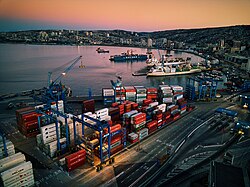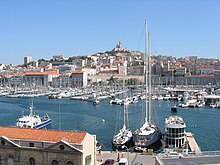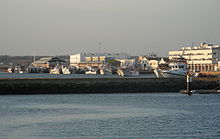Port
A port is a place on the coast that, due to its natural or artificial characteristics, is sheltered from large waves, and where boats can carry out various maneuvers: such as anchoring, mooring, stay and undocking; and operations such as cargo transfer, passenger embarkation and disembarkation. They usually also have services for boats, passengers and cargo.
A natural harbor is a coastal feature made up of a water inlet deep enough to allow boats to anchor, in which the very configuration of the coast provides protection against large waves. Examples of these are the Guantánamo Bay, in Cuba or the port of Kingston in Jamaica, protected by a bar called Palisadoes or the port of Montevideo in Uruguay.
In most cases, engineering works are carried out to build and maintain them. Wave protection is achieved with breakwaters (also called breakwaters) and depth is achieved by dredging.
Ports can be classified by the body of water in which they are located (maritime, lake and fluvial, in the latter case, an example, in addition to being natural, is the port located in Fray Bentos, on the Uruguay River, with access to the Río de la Plata and the Atlantic Ocean). Also, by the main activity that is carried out (commercial, sports, fishing, military) or by the draft that they have. In a deep-water port the draft must be greater than 45 feet (13.72 m).
Zone of a port
From a functional point of view, the works and facilities of a port can be classified by their location. Thus, four different zones are distinguished:
- The maritime zone for the ship, and where the works of shelter are available that protect the area of the outer waves, formed mainly by the dikes; the access works that facilitate the access of the ship to the port in safety conditions, ensuring its maneuverability, width and fit. Among them are the signage (rain, lighthouses, beacons, radiofares, buoys, etc.), the dikes of encauzamiento, channels dredged, locks; the anchoring spaces (rain) with the function of keeping the boat in calm waters, without obstructing the traffic, waiting for its turn of dock in the docks; and the dársenas that constitute the surface of sea to the operation
- The terrestrial zone, intended primarily for the goods, includes the surface of land operation formed by the docks, which in addition to facilitating the trache and mooring of the ships, serve as support for the use and provisional collection of goods; and the deposits that besides adapting a space to the goods, serve as regulation of the marine-terrestrial flows.
- The evacuation zone, intended for land transport, in which the port access routes must be differentiated from the general road network, the circumvalation or distribution network and the penetration of the area of land operation, with its maneuvering and parking areas.
- Occasionally a settlement area of basic industries can be located in the ports: steel, shipyards, petrochemicals, refineries, etc. In some cases it has been necessary to create ports exclusively for your service, such as the case of the external port of Huelva, oriented to the petrochemical industry.
Services provided
The set of services provided by a port can be classified according to the scope for which they are intended.
- Boat services. Between services to the boat are included: the slogan, the practice, the trailer, the maintenance, the fuel charge (in English, bunkering), the discharge of "sloop" (tank wash residues), garbage collection, repairs and maintenance, etc.
- Services to goods. For the services to goods are included: the slogan, stowaway, customs, health, surveillance, commercial services of transitaries, consignors and other agents.
- Land transport services. Them terrestrial transport services are those of representation, trans-shipment and handling of goods.
- Other services. To end, the section Miscellaneous servicesamong those who are insurance, banking, business, communication, etc.
Port Types
Commercial port
It is the most common type of ports, these are dedicated to the loading and unloading of oil, non-oil liquid bulk, solid bulk, passengers, etc. Some examples can be Long Beach, Osaka Barcelona, Shanghai, Callao, Pisco Valparaíso, Cape Town, Hong Kong, Barranquilla, Genoa, Istanbul, Dubai, Buenos Aires, among others.
Sometimes the unloaded merchandise is treated in the same port, which gives way to a variation of it called "factory-port".
Marina
Sports ports are those specially designed to shelter during more or less prolonged stays or serve as a base for recreational boats, which due to their irregular use must spend prolonged stays in the mooring area or in dry dock. Due to the needs to be covered by these ports, they usually present differentiated characteristics with respect to merchant or traditional ports such as dry dock area, dry dock, shipyards or the existence of restaurants, shops and other services focused on a clientele with a certain purchasing power.
Shipyard
The ports or parts of the ports that are specially in charge of the construction or repair of ships are the shipyards with particular facilities of this type. The existence of large cranes, dry docks or various launching areas for ships of different sizes are usually representative of the shipyards.
Fishing port
Those in charge of handling perishable merchandise and especially those intended for the unloading of fish, the fishing ports, contain in their facilities buildings oriented to the sale of these merchandise, the auctions. These ports, being the place of origin for the entry into the market of these products, must be equipped with the logistics and commercial infrastructure to distribute them to the consumption areas.
History
Old Ports
Ancient civilizations that engaged in maritime trade tended to develop seaports. One of the oldest known man-made harbors in the world is located at Wadi al-Jarf on the Red Sea. It seems to have been used as a port since the middle of the fourth dynasty, around 2500 BC. C., and for more than a thousand years. Rock inscriptions show that the site was still in operation around 1450 BC. C. It owed its success to its proximity to the administrative capital of Memphis, which was connected by a 120-kilometre-long road.
Until then it was believed that the first ports built were those of the Phoenicians with the ports of Sidon and Tire in the 13th century a. C. These cities were at their peak and represented important business centers until the attacks of the Sea Peoples. These ports allowed trade, but also the departure of settlers and the support of naval units.
Other ancient ports include the port of Canton or Guangzhou, during the Chinese Qin dynasty, and Canopus, the main Egyptian port for Greek trade before the founding of Alexandria. In ancient Greece, the port of Piraeus in Athens was the base of the Athenian fleet that played a crucial role in the Battle of Salamis against the Persians in 480 BC. c.
The next step in the development of ports is the construction of Alexandria in Egypt, around the III century. The Heptastadion dam is built there, to separate the port into two accessible parts depending on the origin of the wind. It is also the site of the Lighthouse of Alexandria, the first of the lighthouses. Thus, ports developed along the Mediterranean, especially the port of Piraeus in Athens and Ostia in Rome. Mention may also be made of the port of Syracuse and that of Carthage. The construction techniques of the time used mainly local rocks, which required a lot of labor, but offered extremely durable constructions; current marine archeology uses it extensively. You can also see the use of dikes in semicircular arches by the Romans, which allow better resistance to waves.
Ports in the Middle and Modern Ages
Despite destruction after the end of the Roman Empire, ports developed on the shores of the Mediterranean and progressively on the Atlantic side as trade expanded. The Italian ports (Genoa, Venice...) gained importance; the techniques remained substantially the same.
Today, many of these ancient sites no longer exist or function as modern ports. Even in the most recent times, ports are sometimes not used. Rye (East Sussex), was an important English port in the Middle Ages, but the coastline changed and is now 2 miles from the sea, while the ports of Ravenspurn and Dunwich have been lost to marine erosion.
Ports in the contemporary age
It was not until the XIX with the industrial revolution that the appearance of ports clearly changed: the specialization between commercial ports, fishing and military appeared and the concrete allowed other types of construction. In addition to warehouses are railway lines and cranes. The docks expanded and the professions specialized.
While early ports used to be simple ports, modern ports tend toward multimodal distribution, with transportation links to sea, river, canal, rail, and air routes. Successful ports optimize access to an active hinterland. Ideally, a port will grant ships easy navigation, and provide shelter from the wind and waves. Ports are often in estuaries, where the water may be shallow and may need regular dredging. Deep-water ports are less common, but can handle larger ships such as oil tankers, Panamax tankers, and container ships. Other businesses, such as logistics centers, warehouses and carriers, and other processing facilities, find it advantageous to locate within or near a port. Modern ports will have specialized cargo handling equipment such as cranes, stackers, and forklifts.
Ports typically have specialized functions: some tend to serve primarily passenger ferries and cruise ships; some specialize in container traffic or general cargo; and some ports play an important military role for their nation's navy. Some third world countries and small islands such as Ascension and Saint Helena continue to have limited port facilities, so ships must anchor while their cargo and passengers come ashore by barge or launch respectively.
Although modern ships tend to have stern drives, many port authorities still require ships to use a pilot and tugs to maneuver large ships in tight spaces. For example, ships approaching the Belgian port of Antwerp, an inland port on the Scheldt River, are required to use Dutch pilots when navigating the Dutch part of the estuary.
Ports with international traffic have customs facilities.
Today, the fastest growth in port development is by far in Asia, the continent with the world's largest and busiest ports, such as those of Shanghai, Singapore, Shenzhen, Ningbo-Zhoushan and Hong Kong. In recent years, the top ten ports in the world in occupancy, by total number of twenty-foot container equivalent units (TEU), are Asian.
Museums
Between port museums and naval museums there is a wide international representation of this type of museum, drawing attention to naval museums in places far from the sea such as the Naval Museum of Madrid or others that due to their secular tradition deserve mention such as the Royal Shipyards of Barcelona or the Greenwich National Maritime Museum.
Additional bibliography
- Grupo ADUAR: Zoido Naranjo, Florencio; de la Vega Benayas, Sofia; Morales Matos, Guillermo; Mas Hernández, Rafael y Lois González, Rubén C. Dictionary of urban geography, urbanism and land management. Editorial Ariel, S.A Barcelona 1.a edition: November 2000 ISBN 84-344-0519-9 p 303-304
- Cifuentes Lemus, Juan L.; Torres-García, Pilar; Frías M., Marcela (1997). Cap. X: The ports. Different types and categories. The ocean and its resources VII. The use of sea resources. Series: Science for All - Biology (2nd edition). Mexico: Fund of economic culture. ISBN 968-16-5256-8.
Contenido relacionado
Province of La Rioja (Argentina)
Department of Potosi
Coordinated Universal Time









